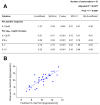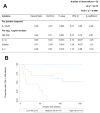Plasma cytokine levels during acute HIV-1 infection predict HIV disease progression
- PMID: 20224308
- PMCID: PMC3001189
- DOI: 10.1097/QAD.0b013e3283367836
Plasma cytokine levels during acute HIV-1 infection predict HIV disease progression
Abstract
Background: Both T-cell activation during early HIV-1 infection and soluble markers of immune activation during chronic infection are predictive of HIV disease progression. Although the acute phase of HIV infection is associated with increased pro-inflammatory cytokine production, the relationship between cytokine concentrations and HIV pathogenesis is unknown.
Objectives: To identify cytokine biomarkers measurable in plasma during acute HIV-1 infection that predict HIV disease progression.
Design: Study including 40 South African women who became infected with HIV-1 and were followed longitudinally from the time of infection.
Methods: The concentrations of 30 cytokines in plasma from women with acute HIV-1 infection were measured and associations between cytokine levels and both viral load set point 12 months postinfection and time taken for CD4 cell counts to fall below 350 cells/microl were determined using multivariate and Cox proportional hazards regression.
Results: We found that the concentrations of five plasma cytokines, IL-12p40, IL-12p70, IFN-gamma, IL-7 and IL-15 in women with acute infection predicted 66% of the variation in viral load set point 12 months postinfection. IL-12p40, IL-12p70 and IFN-gamma were significantly associated with lower viral load, whereas IL-7 and IL-15 were associated with higher viral load. Plasma concentrations of IL-12p40 and granulocyte-macrophage colony-stimulating factor during acute infection were associated with maintenance of CD4 cell counts above 350 cells/microl, whereas IL-1alpha, eotaxin and IL-7 were associated with more rapid CD4 loss.
Conclusion: A small panel of plasma cytokines during acute HIV-1 infection was predictive of long-term HIV disease prognosis in this group of South African women.
Figures





Similar articles
-
Plasma Cytokine Levels in Chronic Asymptomatic HIV-1 Subtype C Infection as an Indicator of Disease Progression in Botswana: A Retrospective Case Control Study.AIDS Res Hum Retroviruses. 2016 Apr;32(4):364-9. doi: 10.1089/AID.2015.0163. Epub 2015 Oct 21. AIDS Res Hum Retroviruses. 2016. PMID: 26414751 Free PMC article.
-
Acute plasma biomarkers of T cell activation set-point levels and of disease progression in HIV-1 infection.PLoS One. 2012;7(10):e46143. doi: 10.1371/journal.pone.0046143. Epub 2012 Oct 2. PLoS One. 2012. PMID: 23056251 Free PMC article.
-
Pre-infection plasma cytokines and chemokines as predictors of HIV disease progression.Sci Rep. 2022 Feb 14;12(1):2437. doi: 10.1038/s41598-022-06532-w. Sci Rep. 2022. PMID: 35165387 Free PMC article. Clinical Trial.
-
Plasma concentrations of transforming growth factor beta 1 in non-progressive HIV-1 infection correlates with markers of disease progression.Cytokine. 2016 May;81:109-16. doi: 10.1016/j.cyto.2016.02.009. Epub 2016 Mar 14. Cytokine. 2016. PMID: 26986868
-
Cytokines and HIV-1: interactions and clinical implications.Antivir Chem Chemother. 2001 May;12(3):133-50. doi: 10.1177/095632020101200301. Antivir Chem Chemother. 2001. PMID: 12959322 Review.
Cited by
-
A pilot investigation of the association between HIV-1 Vpr amino acid sequence diversity and the tryptophan-kynurenine pathway as a potential mechanism for neurocognitive impairment.Virol J. 2024 Feb 23;21(1):47. doi: 10.1186/s12985-024-02313-1. Virol J. 2024. PMID: 38395987 Free PMC article.
-
Antiviral mode of action of bovine dialyzable leukocyte extract against human immunodeficiency virus type 1 infection.BMC Res Notes. 2011 Nov 1;4:474. doi: 10.1186/1756-0500-4-474. BMC Res Notes. 2011. PMID: 22044844 Free PMC article.
-
High Plasma Levels of sTNF-R1 and CCL11 Are Related to CD4+ T-Cells Fall in Human Immunodeficiency Virus Elite Controllers With a Sustained Virologic Control.Front Immunol. 2018 Jun 18;9:1399. doi: 10.3389/fimmu.2018.01399. eCollection 2018. Front Immunol. 2018. PMID: 29967620 Free PMC article.
-
Sex differences in soluble markers vary before and after the initiation of antiretroviral therapy in chronically HIV-infected individuals.AIDS. 2016 Jun 19;30(10):1533-42. doi: 10.1097/QAD.0000000000001096. AIDS. 2016. PMID: 26990631 Free PMC article.
-
Defective iron homeostasis in human immunodeficiency virus type-1 latency.Curr Trends Immunol. 2016;17:125-131. Curr Trends Immunol. 2016. PMID: 28824260 Free PMC article.
References
-
- Deeks SG, Kitchen CMR, Liu L, Guo H, Gascon R, Narvaez AB, et al. Immune activation set point during early HIV infection predicts subsequent CD4 + T-cell changes independent of viral load. Blood. 2004;104:942–947. - PubMed
-
- Stacey AR, Norris PJ, Qin L, Haygreen EA, Taylor E, Heitman J, et al. Induction of a striking systemic cytokine cascade prior to peak viraemia in acute human immunodeficiency virus type 1 infection, in contrast to more modest and delayed responses in acute hepatitis B and C virus infections. J Virol. 2009;83:3719–3733. - PMC - PubMed
-
- Hazenberg MD, Otto SA, van Benthem BHB, Roos MTL, Coutinho RA, Lange JMA, et al. Persistent immune activation in HIV-1 infection is associated with progression to AIDS. AIDS. 2003;17:1881–1888. - PubMed
Publication types
MeSH terms
Substances
Grants and funding
LinkOut - more resources
Full Text Sources
Other Literature Sources
Medical
Research Materials

